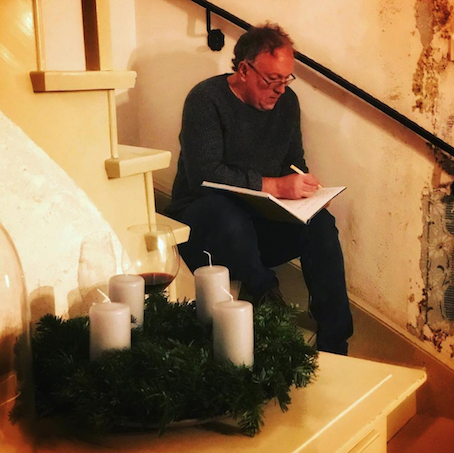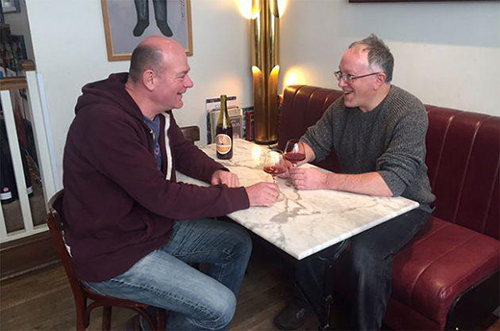…And influenced me to do what? To run shrieking “eureka” through the streets? To put aside my nefarious plans to take over the world? To retreat to the hermetic life, a sadder and wiser man?
The best, most beautiful wines are not necessarily those that have the greatest effect on one.

Sometimes one experiences a particular wine in a deep and meaningful way, and this may take the form of full-fledged epiphany with hand-wringing hosannas, sometimes the flavours are so shocking (in a good sense) that they cause the rearrangement of the shape of one’s palate and persuade one to avidly seek further examples of wines in a similar idiom. Wine, as we know to our delight, can elicit profound reactions if it is the right wine at the right time, and one is attuned to its nuanced charms.
For me, a great wine lives in that beautiful tension between the moment when it is first experienced and in the memory when that experience is recollected and enjoyed again.
I can’t remember my first encounter with wine. When I was a boy, I saw it as a drink for grown-ups. My father kept a weighty tome in which he lovingly glued labels removed from the treasured bottles the contents of which he had consumed. He spent many happy hours in sundry London wine merchants scouring their shelves for bargains. From his demeanour, I sensed that wine had hierarchies – and hierarchies within hierarchies and the subject enshrined in a mysterious freemasonry that I would never be privy to.
My dad allowed me bee sips of alcohol. I was allowed, for example, to eat the gin-soaked lemon peel from his dry martini. I was a strange boy. I do recall some old Riojas, the colour of tawny port and smelling like old libraries given a quick once-over with beeswax furniture polish.
For me, a great wine lives in that beautiful tension between the moment when it is first experienced and in the memory when that experience is recollected and enjoyed again.
Bernard: Old wine is good wine.
Manny: Yes, but expensive wine is good wine also.
Bernard: Yes, but the older the wine is, the gooder it is.
Because of this (the Rioja not the episode of Black Books), I believed that old (brown) wine was great (or gooder) wine and, as a result, gravitated towards reds that exhibited more than their fair share of aromas and flavours of sous-bois, mushroom/truffle and cooked meats. As for whites, I relished obviousness such as Chardonnays that you could use to butter popcorn and Sauvignons that could substitute for a fruit salad.
We all have to start somewhere.
The original epiphany
Chateau Talbot, Saint-Julien 1978
This was the pluperfect wine epiphany fluke. Angels x trumpets x Nature with a capital N turning up the volume to 11 on a night where I would have had to have my head in a bucket not to appreciate the beauty of what was in front of me. The wine was in the background of the scenario in question, necked as it was under a fiery Hebridean night sky of milky-way-muslin and shooting stars, in an amphitheatre of circling mountain and sea. Forty years on, the memory is still strong, and the experience of the wine is still vivid. For a full description of this epiphany, read here.
Regarding Snifters of…
Chateau Margaux (1955) and Chateau Cheval Blanc (1982)
Once upon a time, I was lucky enough to be working as a somm at a restaurant that had a pelagic list including venerable references from Bordeaux and Burg dating back to the 1940s, Californian classics from spectacular vintages, and some toothsome super-Tuscans.
The restaurant had just been converted from club-style fine dining into a modern fish bistro with a rock-and-roll attitude – and chips with everything. When I arrived, I discovered a slimline list sparsely populated with wine cliches: Sancerre, Pouilly-Fume, Chablis, Pinot Grigio, Marlborough Sauvignon etc and seemingly nowt else. Yet when I unlocked the door of the wine cellar for the first time, a six chambered vault underneath the street, I encountered an incredible dust-gathering array of classic red wines from amazing vintages. That token entrecote steak on the menu was going to have to do a lot of heavy lifting!
Over two years, through a mixture of charm and bullying, I managed to sell all these fine wines from another age. And for quality control reasons and to sharpen my education, I contrived to sneak the odd taster too. Two special bottles shone amongst the claret glitterati. One was a vintage of Chateau Margaux (1955) served to a table of oligarchs eating poached eggs with smoked salmon. Just adding that detail for local colour, but suffice to say that the diners in question were merely interested in ordering the most expensive wine on our list. I was just about to serve the Margs straight from the bottle sans fanfare when a waiter tugged my sleeve pointedly. “You must decant it!” Folderol and fiddlesticks! I dutifully fetched a wicker wine cradle and a candle and gently inverted the bottle to pour the precious liquid into a clean decanter. Unfortunately, I had positioned myself next to the door to the kitchen, which would swing open periodically (kicked by a waiter laden with plates rushing through), thus smacking against my pouring arm, this impact consequently propelling a healthy proportion of the wine out of the decanter and mainly over me. What I inadvertently “poured” and deliberately licked off my hand was so beautiful and fragrant, that it might have been at the Platonic ideal of a Chateau Margaux. To attempt to describe such a wine is a nonsense. Imagine a swoon of silk and violets.
The Cheval Blanc in this story was 1982. Our lengthy list was studded with 83s, 85s, 86s and 89s, but this was the sole wine from the year that had become part of Parker folklore as the vintage of 100-pointers. Anyway, when the wine was ordered, I omitted to leave myself the customary pour–boire when decanting the wine. As I grumpily made my way to the cellar clutching the bottle mouthing “Denied!” (It was two years after Wayne’s World, forsooth), I put Cheval to my lips and took a deep (imaginary) swig. As it turned out, I had not done – recurrent motif emerging here – a great job in decanting – and my open mouth duly received with massive pleasure a big dollop of Saint-Emilion’s finest brew. The hedonistic sensation reminded me of how Pierre Brasseur in the movie Les Enfants du Paradis described the impression of a wine as “Like God slipping down your throat in red velvet breeches.”

The first encounter with natural wine
Oliver Cousin Chardonnay & Clos des Vignes du Maynes Macon-Cruzille Aragonite.
It would be fair to say that two different wines drunk in one restaurant (in 2005 I would surmise), one after the other, launched me on my natural wine journey. Or, more accurate to say, the experience made me more adventurous in my wine choices and caused me to reconsider my sense of taste. A little context here as well. The previous evening, Eric, Chris Galvin and I had dined at L’Aubrac in Paris. Having pored over the extensive list, Eric ordered an armful of natural wine classics (as one might call them). Everything we tasted was “off song”. A couple of corked bottles started the proceedings, others were plain out of condition, and the rest thoroughly disjointed, soupy, clumsy and simply unappealing. We were gutted. For me, one ineluctable wine truth emerged from such carnage, being that the more bottles you open in search of the one bottle you might enjoy, the less likely you are to attain that objective.
The first bottle to be uncorked was a Chardonnay from Olivier Cousin. Whoever he was. I remember the effect rather than the precise taste of the wine, which was one of being jolted awake by new aromas, flavours and textures.
Before driving back to London, we stopped for a swift lunch in a tiny Parisienne bistro, owned and run by a woman called Dani. There was a simple no-choice three course menu (I recall a delicious leg of rabbit slow cooked in a tangy mustard sauce) and a wine list numbering 400+ references. Dani said she would take care of the wine choices. I had a good feeling about this. The first bottle to be uncorked was a Chardonnay from Olivier Cousin. Whoever he was. I remember the effect rather than the precise taste of the wine, which was one of being jolted awake by new aromas, flavours and textures. Although I liked to believe that I was an instinctive taster with an untrained palate, I was probably quite conservative, looking for shapes and structures. Up to this very moment. Then pow! What was in my mouth? Something truly elemental. Textures rough, edges jagged, energy raw and kinetic. The wine, not a wine as I knew it, was a law unto itself, and I was bowled over – not that I was even sure that I liked the wine! Still processing, but not fully processing what I had tasted, a second punch to the palatal solar plexus, namely a Macon-Cruzille from Julien Guillot, a wine in the same idiom, a tad less dissonant, but equally vibrant and tactile and charged. So, these were what was known as natural wines. The door of wine perception swung open at that moment.
Since that time, there have been countless other life-affirming, mind-expanding bottles. The best of these conjure powerful emotions. Others are aesthetically beautiful. And still others bequeath almost everlasting pleasure. Without the wines mentioned above, the journey may have taken a lot longer, or may never even started at all.

